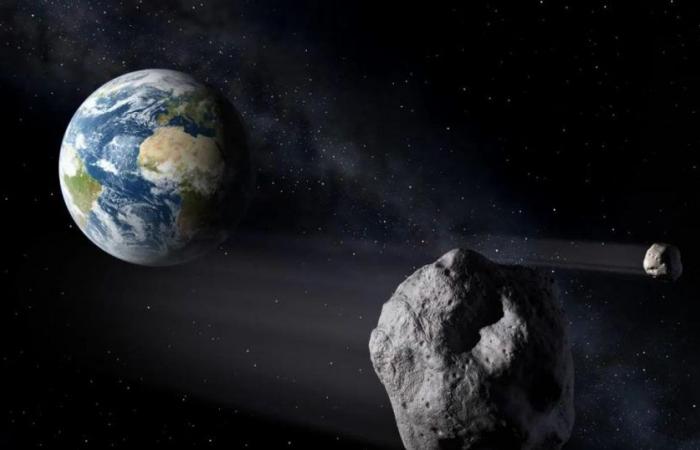If we look at our nearby Moon with binoculars or a small telescope, we will see that its surface is riddled with impact craters. And if we move around the solar system, we will see that all bodies with solid surfaces bear scars that tell us a story: asteroid impacts are a phenomenon that has occurred in the past, is occurring today, and will of course also occur in the future.
Although the frequency of impacts is now much lower than at the beginning of the formation of the solar system, the number of objects that still wander through space leaves us with a very clear message: we are going to continue to suffer from them. As they say in astronomy, It is completely certain that we will be hit by an asteroidbut we still don’t know when it will happen.
Every solid-surfaced body in the solar system is riddled with impact craters. This mosaic shows the Moon’s south pole as observed by NASA’s Clementine spacecraft. Image: NASA/JPL/USGS
On our planet, the traces of these impacts do not last long. The atmosphere, erosion caused by rain and wind, together with plate tectonics, have managed to erase almost all traces of impacts on our crust. Despite everything, at least 200 of these craters have already been located on our planet, most of them almost imperceptible, but some very striking such as the Barringer crater in Arizona, the Lonar crater in India or the Manicouagan Crater in Canada.
The Meteor Crater in Arizona is one of the best preserved in the world. About 50,000 years ago, a 50-meter metallic asteroid impacted there, causing a crater 1,200 meters in diameter and 210 meters deep. Image: USGS National Map Data Download And Visualization Services
The Chelyabinsk event
On February 15, 2013, the world held its breath. At 03:20 UTC (universal time), a small meteoroid of about 18 meters in diameter and weighing about 11,000 tons came into contact with the Earth’s atmosphere at a speed of about 19 km/s, over the Russian town of ChelyabinskSeconds later, the object exploded at an altitude of 15 km with a power equivalent to that of thirty Hiroshima bombs.
The violent explosion left more than 1,500 people injured due to the shockwave, broken glass, collapsed walls and fragments of many buildings falling. Thanks to the fact that the event was recorded by numerous cameras in vehicles and buildings, this phenomenon had a huge impact on all the media around the world. Humanity could no longer ignore this issue and, although luckily this was a small object, we could no longer say that we had not been warned.
Asteroid Bennu as observed by NASA’s OSIRIS-REx spacecraft in 2018. With its carbonaceous composition and 500-meter diameter, it is the prototype of an asteroid that could give us a scare one day. Image: NASA/Goddard/University of Arizona
After the scare, ‘Asteroid Day’ gets underway
The following year, a group of scientists and public figures who were seriously concerned about the issue decided to meet and agreed on the need to raise awareness in society about the problem of asteroids and the potential threat they pose to the planet and humanity.

In this select group were Bryan May (astrophysicist and guitarist of Queen), the physicist Stephen Hawkingastronaut Rusty Scheweickart, film director Grig Richters and Danica Remy, president of the B612 Foundation. With a clear objective, in October 2014 they held a press conference to announce ‘Asteroid Day’, which will serve to coordinate numerous days, conferences and activities around the world, as well as the creation of a foundation that will manage all this informative work.
Brian May at the Asteroid Day press conference in 2015, alongside Stuart Clark. Image: Asteroid Day
The UN supports the initiative and the day of celebration is changed
Two years later, the United Nations Organization (UN) decided to adopt the event and on December 6, 2016 issued an official statement designating the June 30 as ‘International Asteroid Day’. From then on, this day will be dedicated to holding events around the world ‘to promote public awareness about the risks of asteroid impact’. And the date chosen is not coincidental, since it coincides with the anniversary of the Tunguska impact (Russian Federation) in 1908.
Furthermore, this statement reinforces the importance of two groups recently created by the UN: the ‘International Asteroid Warning Network’ (IAWN) and the ‘Space Mission Planning Advisory Group’ (SMPAG). Both groups are made up of the majority of space agencies, observatories and institutions around the world that are specialized in searching for and monitoring asteroids in space. Their job will be to monitor, warn and design a space mission in the event that an asteroid becomes a threat to our planet in the future.
The Tunguska event
On the morning of June 30, 1908, an object of approximately one hundred meters in diameter entered the Earth’s atmosphere over eastern Siberia. At a height of about five kilometers, the object exploded with a yield of about 20 megatons. The explosion left no impact crater, but destroyed more than 100,000 hectares of land. 2,000 square kilometers forests. Fortunately, at that time it was an uninhabited region and no injuries or victims were recorded due to the powerful event.
Image of the Tunguska forests taken in 1929, two decades after the event. Image: Vokrug Sveta, 1931 – public domain
Unfortunately, there were no relatively close witnesses either and the only evidence available is the region’s own burned and fallen trees, as well as some remains of minerals unusual in the area. To this day, the characteristics and dimensions of the object, which could be of asteroidal or cometary origin, are still not very clear. As it is the most powerful impact recorded in recent human history, the UN chose this date to celebrate Asteroid Day annually.
Global awareness events
For the past decade, educational events have been held around the world to mark this day, organised by associations, space agencies and museums. Thanks to these initiatives, awareness of this problem is growing and the need to finance solid and stable projects that will allow us to discover the thousands of asteroids that we still do not know about is very clear.
To date, none of the 35,152 near-Earth asteroids (NEO) discovered, nor the 2,576 potentially dangerous asteroids (PHO) that we know of, pose an imminent threat. However, there is still much to be done, as we know nothing about the 15,000 asteroids that we have left to discover with orbits close to our planet. We still have a long way to go in this task on which our future may depend.






